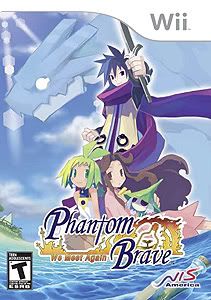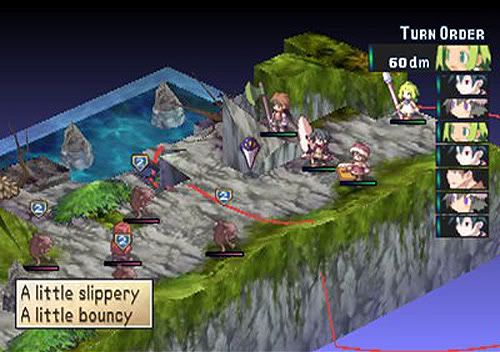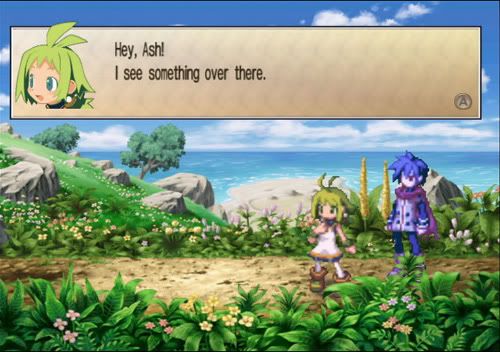
Phantom Brave: We Meet Again
Genre: Tactical RPG
Developers: Nippon Ichi Software, System Prisma
Publisher: NIS America
Release Date: 08/14/2009
Despite being a fan of tactical RPG series such as Shining Force, Fire Emblem and Ogre Battle, I surprisingly haven’t much explored the world of Nippon Ichi. Oh sure, like any curious strategy fan I’ve dabbled with Disgaea, but I wouldn’t know a La Pucelle from a Makai Kingdom (jeez, NIS games are murder on Word’s spellchecker). So it was with a fair amount of anticipation that I truly dove into my first NIS strategy game with Phantom Brave: We Meet Again, the revamped Wii version of the 2005 PS2 game. So, should you brave Phantom Brave? Read on to find out (and sorry about that pun).
1) Story/Modes
The main character in our story is Marona, a young girl whose parents were killed shortly after she was born. Marona is now a Chroma (basically a bounty hunter of sorts) who has the ability to see ghosts or “phantoms,” which brings us to Ash, the other main character. Ash is a phantom who knew Marona’s parents in life, and swore to them before they died that he’d watch over her. Apparently this “watching over her” involves allowing her to travel around the world fighting murderous monsters. Go figure.
It’s an interesting setup, but it’s not particularly well told. The game basically drops you into the midst of the proceedings without explaining much. What’s a Chroma? How did Marona develop this relationship with phantoms? What, exactly, happened to her parents? Most of this is explained eventually, but initially it’s all quite confusing. Instead of being hooked, you spend your time wondering if you somehow missed a cutscene where all these terms they’re throwing around were explained.

The story unfolds in an episodic format and for quite a while there isn’t much in the way of an overarching plot. Marona and Ash have an adventure here, an adventure there, and there’s a lengthy bit of time devoted to Marona becoming friends with a wheelchair bound girl named Castille that feels like pure padding. Eventually a more solid plot comes into focus, but it’s nothing that special. The evil entity that killed Marona’s parents is back to threaten the world you see. Power needed to face the big baddie is gathered, characters make noble sacrifices and so on. Pretty textbook stuff.
Ultimately the story’s fatal flaw is that I simply never found myself caring much about Marona or Ash. Their personalities never seemed to run deeper than what you’d see on a typical bad Saturday morning anime series.
Phantom Brave: We Meet Again also includes an entirely new quest to play called “Another Marona”Â. I actually liked the story for this second quest more than that of the original game. There’s less directionless diddling around in the beginning, with the story kicking off in a pretty ballsy way. That said, even after playing through two full adventures with them, I still didn’t care much about Marona or Ash.
Story Rating: Decent
2) Graphics
This is not a good-looking game. The battlefields, which you’ll be spending most of your time looking at, combine dated 3D backgrounds with blocky low-res 2D sprites. The backgrounds are, without exaggeration, almost N64-level, to the point where it negatively effects gameplay. The battlefield in a good tactical RPG should be as clean, sharp and easy to read as possible, and unfortunately the backgrounds in Phantom Brave are often a chunky, blurry mess. The characters are well designed and animate well enough, but the sprites are inexcusably low-res. I’ve downloaded SNES games off the Virtual Console with sprites less blocky.

The one redeeming visual aspect of the game are the pre-rendered backdrops during cutscenes. These are actually detailed and look super sharp even on a big HDTV, which begs the question, why does the rest of the game have to look like it was constructed with Legos or smeared with Vaseline?
Graphics Rating: Bad
3) Sound
As bad as the game’s visuals are, Phantom Brave’s excellent music almost redeems the game’s presentation all on it’s own. The tunes are catchy, and perfectly capture the usually upbeat vibe of the game. The voice work is also solid, although I found Marona’s voice a bit grating. We get it, she’s cute, she doesn’t need to sound like a chipmunk that just inhaled an entire tank of helium.
Sound Rating: Great
4) Control and Gameplay
There are few video game genres as stubbornly conservative as the tactical RPG. Most games in the genre play very similarly, with only minor tweaks to the well-established template separating one tactical RPG series from the other. So the fact that Phantom Brave actually throws a lot of new ideas at the wall comes as a welcome surprise, but unfortunately the implementation many of these ideas leaves something to be desired.
Each stage begins with only your main character Marona on the battlefield, as she’s the only member of your army that’s actually, you know, alive. The rest of your crew consists of phantoms that Marona has to bind or “confine” to various objects littered around the map. Once confined to an object the character will appear on screen replacing it. The type of object your character is confined to will determine the stat bonuses it gets. Generally speaking, characters that specialize in physical attacks should be bound to sturdy objects like pine trees and rocks, while magic users should be confined to flowers or fruit trees. These objects are scattered all around the map, meaning you can’t just hide Marona in a corner like you can with your leader in other tactical RPGs. Instead, you’re forced to move her around to take advantage of all the confining possibilities.
Another important aspect to take into account is that each spirit can only be summoned for a brief period of time, usually three to five turns. This applies to everybody, even your most powerful characters. Once those turns are up, they’ll revert back to a rock or patch of weeds, and you can only summon them once per battle. This is where most of the strategy in Phantom Brave comes from. You have be very careful about when and where you unleash your characters, or you’ll get to the end of a battle and find you only have under leveled dud characters left to finish the enemy off. This time limit certainly forces you to think, but honestly it doesn’t make the game any more fun than the typical tactical RPG. A lot of the satisfaction in these games comes from building up your favorite characters, and only being about to use them for a few turns each battle just feels like a buzzkill.
Finally Phantom Brave also does away with the traditional tactical RPG grid system. This is the most immediately obvious change to the status quo, but it’s also the least interesting in terms of strategy. Instead of a grid your characters can move anywhere within a circular area surrounding them, which initially feels freeing, but the charm eventually wears off. To me, a good tactical RPG should feel like a well-played game of chess. The movement circles around your characters are simply too large, allowing most characters to cross the entire battlefield in only a few turns. The precise movement and strategy of a Fire Emblem or Ogre Battle is replaced with characters running from one side of the map, to the other and back again. It just feels sloppy, which really characterizes a lot of the gameplay in Phantom Brave.
Your enemies usually don’t exhibit much in the way of intelligent strategy or AI. Their primary mode of attack is to simply surround and swarm your characters, and once you get two or three of your characters surrounded by half a dozen enemies, things get irritating fast. Just trying to target a specific enemy can be a real source of frustration (one which isn’t helped by the unclear visuals). There are all sorts of weird oddities and quirks to the gameplay that only serves to make things more annoying. Sometimes, for no reason the game bothers to explain, you simply won’t be able to target certain enemies at all, your characters can be knocked off the edge of the map and lost for the remainder of the battle, and, in a completely absurd addition, you may even encounter bouncy floors that will bounce your character out of bounds. Is this a game of strategy or Smash Bros?

In between battles you can return home to Phantom Island, where you can summon new characters and manage your army. The phantoms you summon are all generic. You are given no option to change their apearance or do much to alter their abilities, so you never become particularly attached to any of them, like you would in say a Fire Emblem or Shining Force game. Some of your characters serve an extra role on the island, such as the merchant who sells weapons or the healer that resurrects characters defeated in battles. Annoyingly though, all the characters you want to use in battle, as well as all their weapons, have to be represented on your island, which is quite small and quickly becomes cluttered. In order to use the services of say, the healer or the blacksmith you actually have to go up and talk to them, but when your island is packed with a confusing mass of 30 different characters, you’ll wish you could just choose them from a dropdown menu. Managing your army just feels inneficient and unweildy.
As for controls, the developers give you plenty of options (Wiimote and nunchuck, Wiimote only, Classic controller, Gamecube controller) but didn’t bother to make use of any of the Wii’s unique abilities. No pointer control here folks, just impercise d-pad or analog stick movement for you.
Control and Gameplay Rating: Mediocre
5) Replayability
This being a Nippon Ichi title, there’s a huge amount to do for those who get truly immersed in the game. You can play through the main quest and the added “Another Marona” quest in around 30 – 40 hours if you stay focused, but if you want to get the bulk of the unlockables you’ll probably have to spend two or three times that amount of time with the game.
Replayability Rating: Amazing
6) Balance
For the most part Phantom Brave hovers at a nice comfortable level of difficulty, with occasional spikes – usually during important boss battles. Unfortunately all too often you can clear a difficult battle simply by leveling your characters up in randomly generated dungeons, rather than having to devise a winning strategy.
Balance Rating: Good
7) Originality
Like I said before, for the most part the tactical RPG genre takes to change about as well as Rush Limbaugh. So while confinement, character time limits and gridless movement aren’t really that earth shattering, they still represent a pretty big leap for this type of game.
Originality Rating: Very Good

8) Addictiveness
I usually found Phantom Brave’s issues starting to weigh on me after playing through only a couple battles. I had to persevere in order to finish the game for review, but if that weren’t the case I probably wouldn’t play the game for more than half-an-hour at a time.
Addictiveness Rating: Mediocre
9) Appeal Factor
This game’s decrepit visuals and quirky, difficult to grasp gameplay aren’t exactly going to grab the average Wii gamer. Hardcore tactical RPG fans might give it a chance, but the changes to the status quo are just as likely to put them off as entice them, and besides, a lot of hardcore tactical RPG fans probably already played this game five years ago on the PS2.
Appeal Factor Rating: Poor
10) Miscellaneous
Phantom Brave: We Meet Again comes with a bonus art disc, the contents of which you can see in about 5 to 10 minutes. The art is nice enough, but most of it is fairly low res, and the disc only works in your PC. It just seems odd to have a disc come in a Wii box that can’t actually be used in your Wii.
Miscellaneous Rating: Above Average
The Scores
Story/Modes: Decent
Graphics: Bad
Sound: Great
Control and Gameplay: Mediocre
Replayability: Amazing
Balance: Good
Originality: Very Good
Addictiveness: Mediocre
Appeal Factor: Poor
Miscellaneous: Above Average
Final Score: Above Average Game
Short Attention Span Summary
Phantom Brave is an interesting experiment, but not a completely successful one in this reviewer’s opinion. Nippon Ichi gets points for originality for doing away with grids and introducing the confinement system, but rarely do these changes actually make the game more fun than your typical tactical RPG. “If it ain’t broke, don’t fix it” is a good rule to live by, and while playing Phantom Brave I often found myself yearning for the more refined gameplay of a Fire Emblem or Ogre Battle. In a rare case for a remake and/or port, the people I’d recommend this game to most are those who have already played the original. If you liked the original version of the game back in 2004, you’ll find a meaty amount of new content added to the Wii incarnation (the “Another Marona” mode is essentially a full-on second quest). For everyone else, proceed with caution, and give it a rent first. You’ll barely make a dent in the game in a weekend, but you’ll get an idea of whether this new take on the tactical RPG is for you.
Leave a Reply to Diehard GameFAN | Review: Phantom Brave: The Hermuda Triangle (Sony PSP) Cancel reply